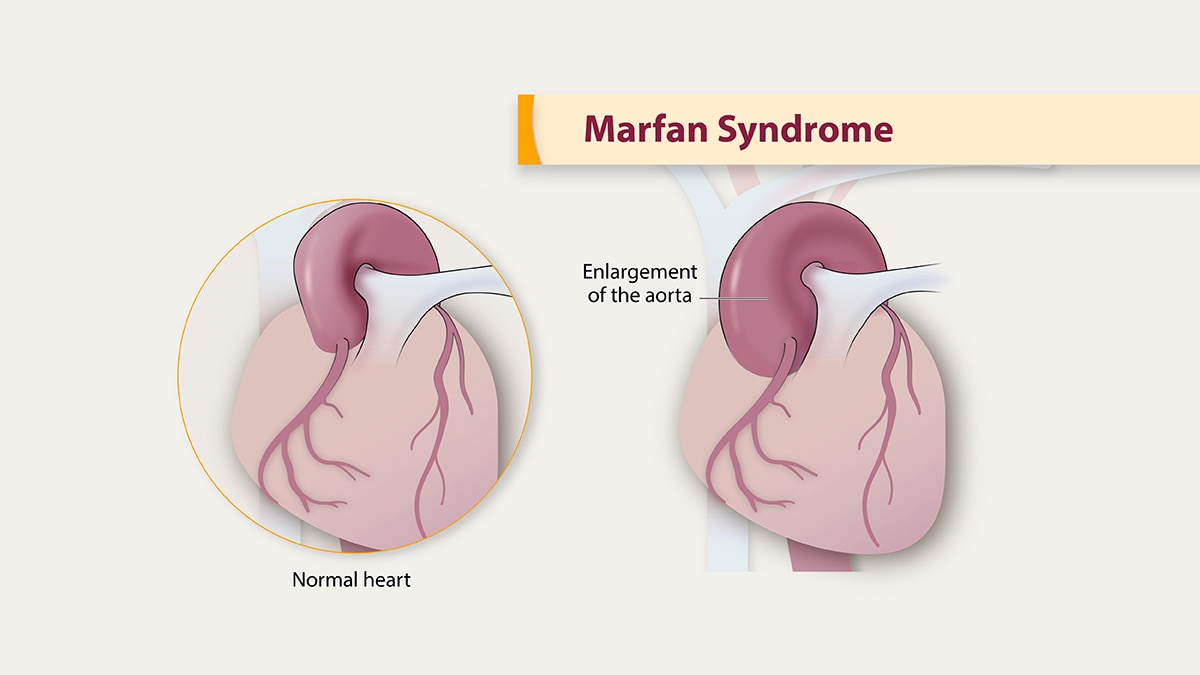Key points
- Marfan syndrome is a genetic condition that affects connective tissue, which provides support for the body and organs.
- Some complications of Marfan syndrome can be very serious.
What it is
Marfan syndrome is a genetic condition that affects connective tissue, which provides support for the body and organs. Marfan syndrome can damage the blood vessels, heart, eyes, skin, lungs, and the bones of the hips, spine, feet, and rib cage. Some complications of Marfan syndrome can be treated or prevented, including heart disease, bone deformities such as a curved spine, eye conditions, crooked teeth, and collapsed lungs.
Some complications of Marfan syndrome can be very serious, like an aneurysm (bulge) of the aorta, the main artery that takes blood away from the heart. An aortic aneurysm can cause the walls of the aorta to tear apart (dissect) and blood to leak in the space created by the tear. An aortic aneurysm can be life threatening.

Causes
Marfan syndrome is rare, happening in about 1 in 5,000 people.1 Marfan syndrome is caused by a mutation in a gene called FBN1. The mutation limits the body's ability to make proteins needed to build connective tissue.1 One in four people with Marfan syndrome develops the condition for unknown reasons.1 A person with Marfan syndrome has a 1 in 2 chance of passing it on to their child.1
How is Marfan syndrome diagnosed?
Recognizing the signs of Marfan syndrome is important for prevention and treatment of serious and even life-threatening complications. People with Marfan syndrome are often tall and thin, with very long arms, legs, fingers, and toes. People who might have Marfan syndrome should be evaluated to help reduce the risk of potential heart problems. It isn't always easy to diagnose Marfan syndrome because it affects everyone a little differently. Some people with Marfan syndrome don't show signs of it until later in childhood or in adulthood.
Testing for Marfan syndrome may include
- Physical exam.
- Family history.
- Eye exam.
- Echocardiogram (using sound waves to look for problems with the aorta and heart valves).
- Genetic testing.
Treatment and recovery
Not everyone with Marfan syndrome has all of the complications. People with Marfan syndrome must be closely followed by their doctor to watch for the following complications:
- Heart disease, including aortic aneurysms and problems with heart valves.
- Bone deformities such as scoliosis (a curved spine) or a breastbone that is sunken or sticks out.
- Eye conditions that can lead to blurred vision or loss of sight. These may include retinal detachment (the retina—the part of the eye that senses light in the back of the eye—peels away from its supporting tissue) or dislocation of the lens (the lens shifts out of place).
- Teeth that are crooked or crowded together, which might require dental procedures.
- A collapsed lung, which makes breathing difficult.
Treatment depends on which parts of the body are affected. An aortic aneurysm may be treated with medicine or medicine plus surgery. Medicine is used to lower blood pressure to help prevent an aneurysm from rupturing and causing a dissection of the aorta.2
Severe scoliosis and breastbone problems may require surgery. Eye conditions may also require surgery.
- National Library of Medicine, Genetics Home Reference. Marfan syndrome. Accessed May 9, 2019.
- Keane MG, Pyeritz RE. Medical management of Marfan syndrome. Circulation. 2008;117(21):2802–2813.
